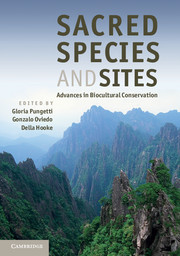Book contents
- Frontmatter
- Contents
- List of Contributors
- Foreword
- Preface
- Acknowledgements
- Introduction
- Part I Concepts and Knowledge
- Part II Sacred Landscapes
- Part III Sacred Sites and People
- Part IV Sacred Species
- Part V Sacred Animals
- Part VI Sacred Groves and Plants
- Part VII Implementation and Conclusions
- Index
- Plate Section
Preface
Published online by Cambridge University Press: 05 August 2012
- Frontmatter
- Contents
- List of Contributors
- Foreword
- Preface
- Acknowledgements
- Introduction
- Part I Concepts and Knowledge
- Part II Sacred Landscapes
- Part III Sacred Sites and People
- Part IV Sacred Species
- Part V Sacred Animals
- Part VI Sacred Groves and Plants
- Part VII Implementation and Conclusions
- Index
- Plate Section
Summary
For us Indians there is just the pipe, the Earth we sit on and the open sky. The spirit is everywhere. Sometimes it shows itself through an animal, a bird or some trees and hills. Sometimes it speaks from the Badlands, a Stone or even from the water. That smoke from the peace pipe, it goes straight up to the spirit World.
Lame DeerAt a time when many animal and plant species, as well as long-established cultural traditions, are threatened by the homogenising effects of modern society and its globalising economies and value systems, this book provides an in-depth investigation of the interaction between traditional spiritual beliefs and practices and nature conservation. Spiritual and cultural values have developed as part of people's relationship with their natural environment. Nature, culture and spirituality are in turn interdependent dimensions shaping our understanding of the existence on this planet. Therefore, the consideration of traditional practices can offer valuable guidance for the future preservation of biological and cultural diversity.
The need to consider ethical, cultural and spiritual values of nature has been increasingly recognised by conservation programmes around the world. International institutions and initiatives are starting to develop legal and policy frameworks based on the integration of such values, together with guidelines for implementation. The recognition of the role of sacred natural sites is one aspect of the holistic conservation approach, as awareness of the cultural and spiritual values of the species and sites of our planet can certainly help to sustain biological and landscape diversity. Despite these recent developments, the specific consideration of the role that sacred species might play in conservation efforts has not yet been comprehensively explored. There is certainly a dearth of studies on species – in terms of plants and animals – which are considered sacred, and on the interrelation between sacred species and sacred sites.
- Type
- Chapter
- Information
- Sacred Species and SitesAdvances in Biocultural Conservation, pp. xxi - xxivPublisher: Cambridge University PressPrint publication year: 2012

